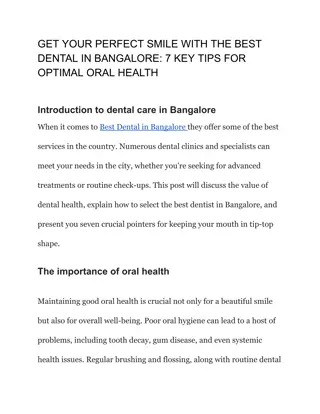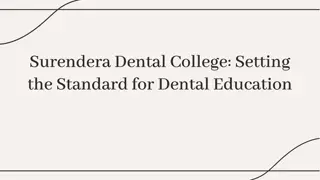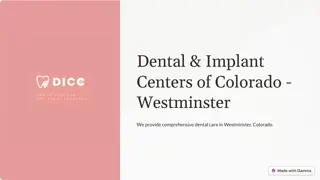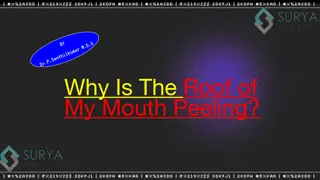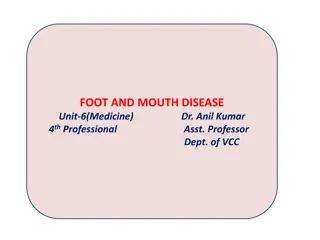Comprehensive Guide to Mouth Preparation for Dental Procedures
Mouth preparation is essential for ensuring the success of various dental procedures. It involves categories such as oral surgical preparation, periodontal preparation, and abutment tooth preparation. The main objectives are to restore oral health and eliminate any conditions hindering the success of the procedure. Oral surgical preparation encompasses various tasks like extractions, removal of roots, and addressing soft tissue abnormalities. Additionally, conditioning of abused and irritated tissues is crucial in certain cases before final impressions. Patients requiring conditioning typically exhibit symptoms like mucosal inflammation, anatomical distortion, and discomfort in residual ridge areas. These conditions are often associated with factors like ill-fitting removable partial dentures, nutritional deficiencies, and systemic health issues.
Download Presentation

Please find below an Image/Link to download the presentation.
The content on the website is provided AS IS for your information and personal use only. It may not be sold, licensed, or shared on other websites without obtaining consent from the author. Download presentation by click this link. If you encounter any issues during the download, it is possible that the publisher has removed the file from their server.
E N D
Presentation Transcript
Mouth preparation Mouth preparation includes 3 categories:- 1. Oral surgical preparation. 2. Periodontal preparation. 3. Preparation of abutment teeth.
Objectives of mouth preparation : Objectives of mouth preparation :- - are to return the mouth to optimum health and to eliminate any condition that would be detrimental to the success of the P.D. All mouth preparation must be completed before the final impression procedures , oral surgical and periodontal procedures should precede abutment tooth preparation and should be completed far enough in advance to allow for a good healing period , a period of at least 6 weeks , but preferably 3 months should be provided between surgical and restorative dentistry procedures .
Oral surgical preparation : Oral surgical preparation :- - 1- Extraction 2- Removal of residual roots 3- Impacted teeth 4- Malposed teeth 5- Cyst and odontogenic tumors 6- exostoses and tori 7- Hyperplasic tissue 8- Muscle attachment and freni
Oral surgical preparation : Oral surgical preparation :- - 9- Bony spines and knife-edge ridges 10- polyps , papillomas , and traumatic hemangiomas 11- Hyperkeratosis , erythroplasia , and ulceration 12- Dentofacial deformity 13- Osseointegrated Devices 14- Osseointegrated Devices
Conditioning of abused and irritated tissues Conditioning of abused and irritated tissues - Many P.D patients may require conditioning of the supporting tissues in the edentulous area before the final impression . Those who need conditioning treatment are those who have the following symptoms :- 1- Inflammation and irritation of the mucosa covering the denture-bearing areas . 2- Distortion of normal anatomic structures such as incisive papillae , the ruage , and the retromolar pads . 3- A burning sensation in residual ridge areas , the tongue , and the cheeks and lips .
Conditioning of abused and irritated tissues Conditioning of abused and irritated tissues These conditions are usually associated with :- 1. ill-fitting R.P.D. 2. poorly occluding R.P.D. 3. nutritional Deficiencies 4. endocrine Imbalances 5. sever health problems (diabetes or blood dyscrasias) 6. bruxism
The treatment procedures include good home care by:- 1. Rinsing the mouth 3 times daily with a prescribed saline solution 2. Massaging the residual ridge areas , palate , and tongue with a soft toothbrush 3. Removing the prosthesis at night 4. Using a prescribed therapeutic multiple vitamins along with prescribed high protein , low carbohydrate diet
Using of tissue conditioning materials : Using of tissue conditioning materials :- - Tissue conditionings are safe elastomers (elastopolymers) used to treat an irritated mucosa supporting a denture. They are mixed at chair side, placed in the denture and seated in the patent's mouth. These materials will confirm the anatomy of the residual ridge, gel in that position and continue to flow slowly after application for extended period of time permitting distorted tissue to rebound and assume their normal form. - These materials have a smoothing effect on irritated mucosa and because they are soft, occlusal force are probably more evenly distributed. - Inhibition of the growth of oral bacterial flora is associated with some materials and this should promote healing of inflamed tissues.
The The properties properties that make tissue conditioners that make tissue conditioners effective are: effective are:- - Viscous behavior which allows adaptation to the irritated denture- bearing mucosa over a period of several days. Viscoelastic and elastic behavior which cushions the cyclic forces of mastication and bruxism. Tissue conditioners are composed of powder containing a poly (ethyl methacrylate) and a liquid containing an aromatic ester-ethyl alcohol up to 30% of the main constituent which is volatile material. Within a few days the tissue conditioners become stiffer as a result of the loss of alcohol.
Tissue conditioners go through different Tissue conditioners go through different stages stages : :- - 1. Plastic stage 2. Elastic stage 3. Hard stage
1- Plastic Stage:- occur after mixing the powder and liquid , the material at this stage responds to functional and parafunctional movement or habits , so not indicated to be used as impression material , this stage take few hours to few days "ask the patient not to eat hard food or very hard materials , only remain in function for few days". Do not use hard brush or any chemical material to clean the denture, just ordinary mouth cleaning and only tap water. 2- Elastic Stage:- the material take body so act as cushion material helps in recovering of mucosa , tell the patient to wear the denture for few days , then check periphery and borders which can be corrected locally after few days , this stage takes one week to 10 days so we should get good periphery , good extension , good mucosa , then pour the impression with ordinary material " with stone or plaster of pairs". 3- Hard Stage:- the material become hard after 10 days like polymerized resin , it's at this stage consideration relining material (not poured).
Maximum benefit from using tissue conditioning Maximum benefit from using tissue conditioning material may be obtained by: material may be obtained by:- - 1. Elimination deflective or interfering occlusal contacts of old denture. 2. Extending denture bases to proper form to enhance support, retention and stability. 3. Relieving the tissue side of denture bases sufficiently 2 mm to provide space for even thickness and distribution of conditioning material. 4. Applying the material in amount sufficient to provide support and cushioning effect. 5. Following the manufactures directions
Periodontal preparation: Periodontal preparation:- - The periodontal preparation follows or is performed simultaneously with the oral surgical procedures . It should be completed before restoration procedures , because the success of this restoration depends on the health and integrity of the supporting structures of the remaining teeth . Therefore the periodontal health of the teeth , especially the abutments must be evaluated and corrective measures taken before R.P.D construction .
Preparation of abutment teeth : Preparation of abutment teeth :- - -After surgery , periodontal treatment, endodontic treatment , and tissue conditioning of the arch involved , the abutment teeth may be prepared to provide support , stabilization , reciprocation and retention of the P.D.
Classification of abutment teeth : Classification of abutment teeth :- - 1. -The subject of abutment preparation can be grouped as follows:- 2. Those abutment teeth that require only minor modification to their coronal portions. 3. Those that are to have restorations other than crowns. 4. Those that are to have crowns.
Sequence of abutment preparation on sound Sequence of abutment preparation on sound enamel or existing restorations : enamel or existing restorations :- - Abutment teeth that require only minor modifications include teeth with sound enamel , those with small restoration not involved in the P.D design , those with acceptable restorations that will be involved in that require minor modification which will not affect the crown , the latter may exist either as an individual crown or as the abutment of fixed P.D abutment preparations on sound enamel or existing restorations.
as acceptable should be done in the following order :- Proximal surface parallel to the path of placement should be prepared to provide guiding planes. tooth contours should be modified , lowering the height of contour so that :- The origin of circumferential clasp arms may be placed well below the occlusal surface, preferably at the junction of the middle and gingival third. Retentive clasp terminals may be placed in the gingival third to the crown for better esthetic and better mechanical advantages. Reciprocal clasp arms may be placed on and above a height of contour that is no higher than the cervical portion of the middle third of the crown of the abutment tooth. After preparation of the axial contours and before rest seat preparation, an impression should be made with alginate and a cast is poured in fast setting stone. Return this cast to the surveyor to determine the adequacy of the axial alteration. If those surfaces need additional alteration it can be performed in the same visit. Occlusal rest areas should be prepared that will direct occlusal forces along the long axis of the abutments.
Mouth preparation should follow the P.D design that was outlined on the diagnostic cast, at the time that the cast was surveyed and the treatment plane was confirmed. Proposed changes to abutment teeth should be made on the diagnostic cast and outlined in red pencil to indicate the area, amount and angulations of the modification to be done.








